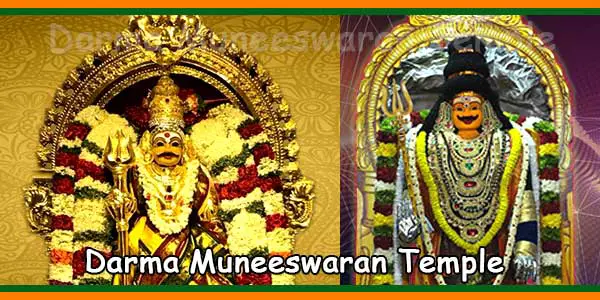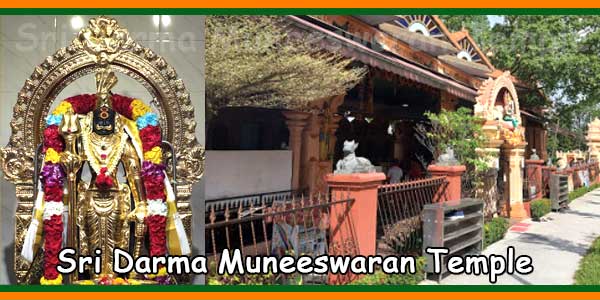Sri Darma Muneeswaran Temple at Serangoon North Avenue 1 in Singapore has existed on its present site for over a hundred years.
It started out as a simple shrine under a Bodhi tree, around 1900. A community of around 30 Indian families residing nearby, mostly involved in cattle ranching activities, likely erected the shrine for protection. It was and still is a common practice for a Muneeswaran deity to set up as a guardian at the entrance to a possessed village. Later, the shrine consisted only of a flat, hemispherical granite stone with inscriptions and a trident placed under a tree. While the trident remains in its original place on the Bodhi tree, the granite stone is now encrusted under Lord Darma Muneeswaran in the present temple complex.
Around the 1930s, many residents of the Kampong Hwi Yoh region claimed to have had visions of Sri Darma Muneeswaran. Therefore, the late Pitchai Pillai and Allagappan Konnar, along with other prominent Indian rulers of the Sembawang Rubber Estate, decided to erect an improved shrine for Lord Darma Muneeswaran.
In 1969, the Hindus who maintained the temple made further improvements and installed additional deities namely Sri Mariamman, Sri Vinayagar, Sri Murugan, Sri Nagar and Sri Bairavar. They also erected a temporary shed to house each deity. Lord Darma Muneeswaran was made of concrete and installed under the Bodhi tree. The Sri Mariamman Shrine was installed between Sri Vinayagar and Sri Murugan and this orientation is still preserved in the present temple complex.
In 1980, the temple was officially registered as the Dharma Muneeswaran Temple Society. With the help of Dr. Lau Teik Soon, MP for Serangoon Gardens and also the temple counselor, the temple obtained a Temporary Occupation License (TOL) dated prior to May 1, 1955. The temple congregation at this time there he had grown to include regular devotees from Serangoon Gardens, Serangoon North, Serangoon Central, Ang Mo Kio, Hougang, Yio Chu Kang, Paya Lebar and Seletar Hills. At the time, the purpose of the temple was to provide religious services to its worshipers. However, by the end of that decade, it became evident that the temple facilities were grossly inadequate to meet the growing needs of an expanding congregation.
Therefore, on September 23, 1989, members of the Dharma Muneeswaran Temple Society unanimously agreed to build a new temple complex at their annual general meeting. This new complex was to house the deities’ inappropriate shrines and provide additional facilities for the faithful to meet not only their religious needs but also their cultural, educational, social and welfare needs. In June 1992, with the support of Dr. Lau Teik Soon, the temple began the process of acquiring its existing TOL site and adjacent lands. At the same time, the temple embarked on drawing up plans for a new building, as well as raising funds to finance the project. After a three-year process, the temple administration acquired the site in 1995 with a 30-year lease.

At the end of 1996, the plans for the new building were presented to the authorities. Care has been taken to ensure that the new temple complex meets Hindu architectural requirements while preserving the Bodhi tree, an emblem of the temple’s historic roots. It had to be done in a modern and sophisticated way and had to blend in naturally with the surrounding environment. Approval for the new building was obtained in mid-1998.
The deities had been moved to a temporary structure during the Balasthaapanam ceremony from September 12 to 14, 1997, the inauguration ceremony took place on May 1, 1998, with the honor of Mr. S Iswaran, then MP for the coast west of the RCMP. Construction of the new $ 3.5 million temple complex began on May 11, 1998, and Maha Kumbhabishegam was held on June 11, 2000, to dedicate the building and all of its deities. The sculptural works in the temple were led by the famous Mr. S Nagarajan Sthapathiyar from Devakottai, while the dedication ceremony was led by Vikas Ratna Dr. K Pitchai Gurukkal from Pillaiyarpatti. The ceremony was led by Mr. Matthias Yao Chih, then Minister of State in the Prime Minister’s Office.
After its official dedication, one of the first things Dharma Muneeswaran Temple did was establish itself firmly not only as a place of worship but also as an active member of the community. The temple was steadfast in its desire to give back to the community that had generously donated for the construction of the new temple.
One of its key initiatives was to provide scholarships to primary and secondary school students in need, across ethnic and religious lines. Since 2003, Drama Muneeswaran Temple has awarded scholarships in excess of $ 500,000, benefiting some 1,600 students. The scholarships serve a useful purpose, but the time firmly believed that it was just as important to recognize and recognize those who have excelled, as they could be an inspiration and role model for others. This triggered the birth of “Munneru!” Program. Additionally, the temple was also aware of having a broad purpose to define success. In addition to scholarships, the temple introduced awards for academic and athletic excellence in 2010.
The temple to this day continues to help the community. The temple serves the young to the old. Each year, the temple encourages students to apply for scholarships. These serve and motivate future generations in our community. By the “Munneru! the program, the temple was created as a support function to further develop and motivate the student through enrichment classes. The temple also actively supports social and community events to give back to society.
As a significant number of participants attend performing arts-related programs, the temple established a Drama, Music and Dance Academy in 2010 to inject greater professionalism into the teaching and learning of performers. arts. This academy is now known as DMT Music and Dance Academy.
Several thousand devotees visit the Darma Muneeswaran temple every week and the number peaks during times of poojas and special festivals. In addition, more than 800 people, young and old, participate in non-religious activities every week.
As the temple complex neared the end of its first 12-year cycle, Darma Muneeswaran Temple decided to update it with new features, carvings, and an additional basement to meet growing religious and secular needs. of his followers. These additions and modifications had an estimated cost of $ 2 million which was completed in May 2012.
The dedication ceremony for the new basement took place on June 3, 2012, and the Balasthaapanam for Rajagopuram and Vimaanams, including all deities, took place in stages on July 8, 2012 and December 9, 2012, respectively. This was done in conjunction with the advancement of additions and renovations to the existing complex. The improvement work was completed in time for his re-dedication, also known as the second Maha Kumbhabishegam, on May 1, 2013.
The second Maha Kumbhabishegam evokes a feeling of déjà vu among his followers. This took place exactly 15 years after the first inauguration ceremony held on May 1, 1998. The second Maha Kumbhabishegam was honored by Mr. S. Ishwaran, Minister of the Prime Minister and Second Minister of Interior and Trade and honored the first opening ceremony. Once again, the sculpture works were directed by Mr. S Nagarajan Sthapathiyar while the re-consecration was directed by Vikas Ratna Dr. K Pitchai Gurukkal.
The improvement of the temple complex and its dedication ceremonies would not have been possible without the vision and efforts of the management committee, fundraising committee, Darma Muneeswaran Thondargal, other volunteers and their devotees. and benevolent sympathizers,
With this in mind, Dharma Muneeswaran Temple is committed to providing a divine experience for all.

Sri Darma Muneeswaran Temple Daily Pooja Timings:
Morning: 7:00 AM to 12:00 PM
Evening: 6:30 PM to 9:15 PM
Every Tuesday Evening Temple Opens at 4:30 PM
Every Sunday Evening Temple Opens at 5:00 PM
Saturday Temple will be closed at 1:00 PM
Darma Muneeswaran Temple Poojai Time:
Kaala sandhi Poojai 7:00 AM
Uchikkaala Poojai 12:00 PM
Saayarakchai Poojai 6:30 PM
Arthajaama Poojai 9:30 PM
Darma Muneeswaran Temple Ragu Kaala Poojai Time:
Ambal Ragu Kaala Poojai – 5:00 PM
Nagar Ragu Kaala Poojai Every Sunday – 5:30 PM
Shiva Temple Deities:
Sri Vinayagar
Sri Murugan
Sri Mariamman
Sri Muneeswarar
Sri Nagar
Sri Gangkala Murthy
Sri Ramar
Sri Anjaneyar
Sri Vairavar
Navagrahas
Singapore Muneeswaran Temple Festivals:
Sri Saarvari New Year
Akshaya Thritheeyai
Commencement of Agni Nakshathram
Chithira Pournami
Conclusion of Agni Nakshathram
Vaikasi Visagam
Aani Uthiram
Aadi 1st Friday
Aadi Amavasai
Aadi Pooram
Aadi Perukku
Sri Vaikanasa Jayanthi
Sri Krishna Jayanthi
Aadi Karthigai
Aadi 5th Friday
Sri Vinayagar Chathurthi
Sarva Mahaalaya Amavasai
Purattasi 1st Saturday
Purattasi Last Saturday
Navarathiri Festival Commence
Sri Saraswathi Poojai
Vijayadhasami
Firewalking Festival
Deepavali
Skandha Shasti Festival begins
Soorasamharam
Thirukarthigai Deepam
Sri Vaikunda Ekadasi
Aarudra Dharisanam
English New Year
Sri Hanumath Jayanthi
Thai Pongal
Thaipusam Festival
Thai Amavasai
Maasi Magam
Maha Sivarathiri
Panguni Uthiram
Sri Darma Muneeswaran Temple Address:
Sri Darma Muneeswaran Temple
17, Serangoon North Ave 1,
Singapore – 555894.
Phone: (+65) 6280 5058
email: dmt@dmt.org.sg
